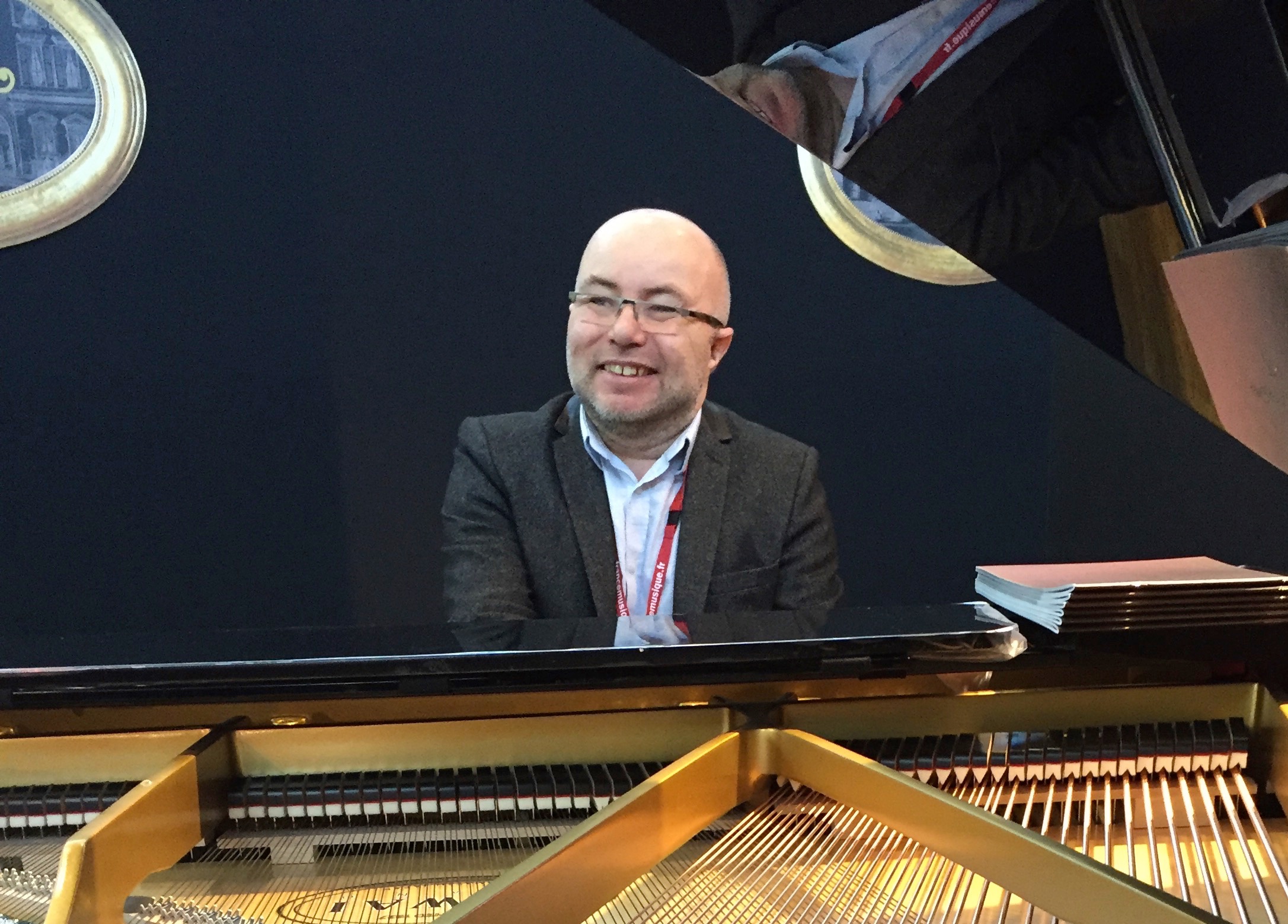-
Posts
1,056 -
Joined
-
Last visited
Content Type
Forums
Events
Store
Video Gallery
Everything posted by Stephane Boussuge
-

Beginner Question: Copy from source to target in specific patterns
Stephane Boussuge replied to Laure's topic in OMN Lingo
Have a look to the Counterpoint function documentation. S. -
Hi Tom, to output midi, you don't need any layout, you can do this. (def-score electronic (:title "electronic music score" :composer "THT" :copyright "Copyright ©2023 " :key-signature 'chromatic :time-signature '((1 1 1 1) 4) :tempo 100 ) (polysynthl :omn polysynth :channel 2 :sound 'gm :program 0 :volume 100 :pan 64 :port 1 :controllers (91 '(72)) ) (polysynthr :omn polysynth :channel 2 :sound 'gm :program 0 :volume 100 :pan 64 :port 1 :controllers (91 '(72)) ) (monosynth :omn monosynth :channel 3 :sound 'gm :program 0 :volume 100 :pan 64 :port 1 :controllers (91 '(72)) ) (modularsynth :omn modularsynth :channel 4 :sound 'gm :program 0 :volume 100 :pan 64 :port 1 :controllers (91 '(72)) ) (padl :omn pad :channel 5 :sound 'gm :program 0 :volume 100 :pan 64 :port 1 :controllers (91 '(72)) ) (padr :omn pad :channel 5 :sound 'gm :program 0 :volume 100 :pan 64 :port 1 :controllers (91 '(72)) ) (kick :omn kick :channel 1 :sound 'gm :program 0 :volume 100 :pan 64 :port 1 :controllers (91 '(72)) ) (snare :omn snare :channel 2 :sound 'gm :program 0 :volume 100 :pan 64 :port 1 :controllers (91 '(72)) ) )
-
Hi, a new test piece made with my template Trio "Infinite Variations" Trio - I can hear the Wind.mp4 i can hear the wind.opmo
-

mapping attributes to Note Length
Stephane Boussuge replied to AndreOktave's topic in Function Examples
Another solution is also possible with the function length-map: (setf omn '((q e3 p -q s a4) (s f3 mp -s) (e g3 mf))) (setf out (length-map '((q ord)(s stacc)(e spicc)) omn)) => ((q e3 p ord - s a4 stacc) (s f3 mp stacc -) (e g3 mf spicc)) -
Infinite Variations - A Motivic Counterpoint Template for Alto Flute, Harp, and Piano Welcome to "Infinite Variations," a groundbreaking template for Opusmodus, meticulously crafted to inspire composers and enthusiasts in the realm of chamber music. This template is not just a tool, but an innovative gateway to an endless array of musical creations for a chamber trio consisting of Alto Flute, Harp, and Piano. At the core of "Infinite Variations" lies a dual-component structure: the template itself, embodying a sophisticated motif-based counterpoint design, and a suite of advanced algorithms. These algorithms are the heart of the template, engineered to generate an extensive variety of musical content, each time yielding a unique and captivating piece. This template transcends traditional compositional methods, integrating algorithmic precision with musical artistry. It is an invitation to explore uncharted musical landscapes, offering composers the freedom to experiment with complex textures and harmonies while maintaining the delicate balance of a chamber ensemble. "Infinite Variations" is more than just a composition tool; it's an artistic companion that pushes the boundaries of algorithmic music composition. Whether you are a seasoned composer or a curious explorer in the world of algorithmic music, this template promises to be a source of endless inspiration and creativity. Get ready to embark on a journey of musical discovery and redefine the possibilities of chamber music composition with "Infinite Variations." ComposerWorkshop
-
New piece made with OM with the algorithms presented in ComposerWorkshop: 5 Opusmodus Lessons stephaneboussuge · Invocation pour ensemble
-

VSL - Vienna Symphonic Library Synchron Prime Edition
Stephane Boussuge replied to Cliff's topic in Library Setup
Yes, here it is. S. SyncPrime.lisp -

length-augmentation to fill rests
Stephane Boussuge replied to TomTolleson's topic in Function Examples
Hi, may be this help: (setf len '(1/8 1/8 -1/4 1/16 1/16 1/16 1/16 1/4 -1/8 1/16 1/16 1/2)) (setf len-only (remove-nils (loop for l in len :collect (if (length-restp l) nil l )))) -

length-augmentation to fill rests
Stephane Boussuge replied to TomTolleson's topic in Function Examples
Hi Tom, the :exclude parameter is for sections, not directly for lengths... To achieve what you want to do, I recommend to separate lengths from rests, apply length-augmentation to lengths and re-assemble a new list with new lengths and unprocessed rests. Best Stephane -
Here's an example of programming for composition, utilizing the techniques described in the "5 Opusmodus Lessons" from composerworkshop.com.
-
New piece composed with the technique used in Composerworksop course: 5 Opusmodus lessons.
-
Hi folks, I am thrilled to unveil my latest course offering on Composerworkshop.com, entitled "5 Opusmodus Lessons." Spanning over 50 instructional videos, these five lessons delve into the sophisticated capabilities of Opusmodus, equipping you with powerful algorithms that will enhance your compositional process. You’ll learn how to generate and manipulate a limitless stream of music, all while maintaining control over every aspect. Take advantage of an exclusive offer starting today until the 24th of November. Enjoy a 20% discount on all video packages, including this brand-new course, by using the promo code "friday20" at checkout. Stephane
-
Hi, I've just finished a new pack of videos lessons for Composerworkshop, this pack will give you some powerful tools and understanding of the power of OM. Here's the course description: 5 Opusmodus lessons: This set of 5 Opusmodus lessons dive into some advanced possibilities of the Opusmodus Music Composition Environment, bringing an exploration of techniques such as Shapes driven tessiture, dynamics and orchestration control, Algorithmic dictum generation for counterpoint, Process driven composition, Spectral harmony exploration and exploration of different pitch distributions across instrumental parts. Who this course is for This course is for moderate to advanced users of Opusmodus. It is highly recommended to get all the basics of Opusmodus before to start this course. What you'll learn in this course: Course 1: Algorithmic Dictum Generation for Counterpoint What You Will Learn: - Understand the structure and utility of counterpoint functions in Opusmodus. - How to manually create simple dictums, a list of pattern numbers and optional parameters. - Algorithmic methods for generating lists of pattern numbers and other parameters for Counterpoint function. - Techniques to assemble the generated material into a usable and readable dictum. - Apply your algorithmically generated dictum in creating a score section using algorithmically designed patterns. Course 2: Pitch Distribution across several instrumental parts What You Will Learn: - How to manually distribute a pitch rowan other pitch material across instrumental parts and understand the underlying logic. - Techniques for algorithmic distribution from top to bottom and vice versa. - Apply rhythm and pitch variations for richer musical output. - Working with various pitch materials like tone rows, Slonimsky patterns, triadic materials, and noise-generated pitch material. Course 3: Iterated Process Driven Composition What You Will Learn: - Introduction to Process-Driven Composition and how to achieve it in Opusmodus. - Utility function definitions for adding rehearsal marks and other elements automatically to generated scores. - Building a process iterations to generate several sections of a piece in one pass based on rules. - How to define your algorithmic process and extract individual instrumental parts. - Implement tempo changes and time signature adjustments. Course 4: Shapes/Vector driven control of Tessiture, Dynamic, Pitch and Orchestration. What You Will Learn: - Techniques for generating pitch material based on smoothed white-noise. - Algorithmic rhythm generation and control through provided density-length functions. - Methods for dynamic markings and ornamentation of repeated notes. - Assemble sections into a complete piece while applying orchestration techniques. Course 5: Spectral Harmony Exploration What You Will Learn: - Techniques for spectral pitch remapping. - Methods for vector generation and pitch contour shaping. - How to import and manipulate spectral data for pitch mapping. - Techniques for ambitus constraint, frames filtering and chord generation in spectral frames. - Learn to apply dynamic markings, articulations, and the play-mute system to your composition. By the end of this course series, you will have a strong understanding of advanced algorithmic composition techniques using Opusmodus. You'll be equipped with the skills to generate sophisticated compositions using an algorithmic approach, taking advantage of Opusmodus's rich set of functions and utilities.
-
I don't know, sorry.
-
We need the variable ry7 not provided here to help you. S.
-
Here's an example of sampler design: (sc:defsynth stf-sampler1 ((buffer 0) (rate 1) (start 0) (amp 0.5) (out 0)) (let ( (sig (sc:play-buf.ar 2 buffer (* rate (sc:buf-rate-scale.ir buffer)) :start-pos (* start (sc:buf-frames.ir buffer)) :act :free))) (sc:out.ar out (* amp sig)))) (defparameter sample1 (sc:buffer-read "/Users/stephaneboussuge/Samples/tibetan-singing-bowl.wav" :bufnum 0)) ;(sc:synth :stf-sampler1) ;(sc:synth :stf-sampler1 :rate 0.5) ;(sc:synth :stf-sampler1 :rate 2) (sc:stop) Hope it helps. Best S.
-
Hi, i have a tendency to use tonality-map with pitch-class sets in that case, something like: (tonality-map '((0 2 4 5 7 9 10) :map 'octave) mat3) => (c4 d4 e4 f4 g4 a4 bb4 c5) S.
-

Supported input forms for Opusmodus-functions
Stephane Boussuge replied to erka's topic in OMN Lingo
A B D are correct. E and H could work under certain condition (pre-processing, flatten-sublist etc...) S. -
New short piece for piano. stephaneboussuge · Prelude pour Piano 160923



